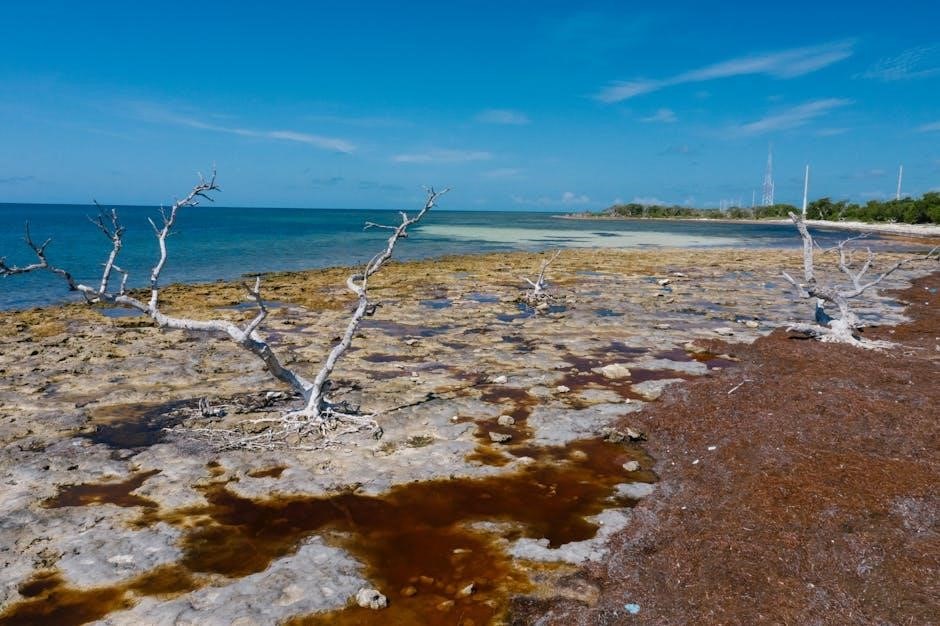Identifying Florida’s diverse tree species is essential for understanding its ecosystems․ With over 200 native species, recognizing trees by their leaves, bark, and flowers is key for enthusiasts and professionals alike․
1․1 Importance of Tree Identification in Florida
Identifying trees in Florida is crucial for preserving its unique ecosystems․ With over 200 native species and numerous invasive ones, accurate identification aids in conservation efforts, ensuring biodiversity and ecological balance․ It helps manage invasive species that threaten native habitats and supports sustainable forestry practices․ Additionally, understanding tree species is vital for urban planning, landscaping, and environmental education․ By using field guides, online databases, and apps, individuals can contribute to better land management and environmental stewardship, ultimately protecting Florida’s rich arboreal heritage for future generations while fostering a deeper connection with nature․
1․2 Overview of Florida’s Diverse Tree Species
Florida boasts an extraordinary variety of tree species, shaped by its subtropical climate and geographic location․ Native species like the majestic cypress and pine dominate natural landscapes, while palms and hardwoods thrive in diverse ecosystems․ Invasive species, such as the Australian pine, have also established a presence, altering local habitats․ Understanding these species is crucial for conservation and management efforts․ This guide provides insights into the state’s arboreal diversity, helping enthusiasts and professionals alike identify and appreciate Florida’s unique tree population through detailed descriptions and visual cues․

Native vs․ Invasive Tree Species in Florida
Native trees like sabal palms and cypress are vital to Florida’s ecosystems, while invasive species such as melaleuca disrupt biodiversity and harm local environments․
Understanding their differences is crucial for conservation and sustainable land management․
2․1 Common Native Tree Species
Florida is home to a variety of native tree species, each adapted to its unique climate and soil conditions․ The iconic Live Oak (Quercus virginiana) is a symbol of the South, with its sprawling canopy and twisted branches․ The Slash Pine (Pinus elliottii) dominates sandy areas, while the Bald Cypress (Taxodium distichum) thrives in swamps and wetlands․ Other notable natives include the Red Maple (Acer rubrum), Southern Magnolia (Magnolia grandiflora), and Tupelo (Nyssa sylvatica)․ These trees play vital roles in maintaining Florida’s ecosystems, providing habitat for wildlife and stabilizing environments․ Field guides and resources like The Sibley Guide to Trees often highlight these species, aiding in identification and conservation efforts․
2․2 Identifying Invasive Tree Species
Invasive tree species in Florida, such as the Australian Pine and Melaleuca, disrupt native ecosystems by outcompeting native plants and altering habitats․ These species often exhibit rapid growth and aggressive spreading behaviors․ Identifying invasive trees requires observing distinctive traits like leaf shape, bark texture, and seed production․ For example, the Australian Pine has clusters of needle-like leaves, while Melaleuca produces white, bottlebrush-like flowers and small, woody seed capsules․ Early detection is critical to prevent their spread and protect biodiversity․ Resources like field guides and online databases can aid in distinguishing invasive species from native ones, ensuring timely management and conservation efforts․
Visual Identification Characteristics
Visual traits like leaf shape, size, and arrangement, along with bark texture and flower features, are crucial for accurately identifying Florida’s tree species, ensuring precise classification and understanding․
3․1 Leaf Shapes, Sizes, and Arrangements
Leaves are crucial for identifying Florida trees, as their shapes, sizes, and arrangements vary widely․ Common shapes include ovate, lanceolate, and elliptical, while sizes range from small (e․g․, red maple) to large (e․g․, live oak)․ Leaf arrangements like alternate, opposite, or whorled provide additional clues․ For instance, palmate leaves, such as those on palm trees, have lobes radiating from a central point․ Field guides often highlight these characteristics, making them essential tools for accurate identification․ Observing these traits helps distinguish native species from invasive ones, aiding conservation efforts and ecological understanding․
3․2 Bark Patterns and Textures
Bark patterns and textures are crucial for identifying Florida trees․ Species like the Bald Cypress exhibit fibrous, peeling bark, while the Southern Magnolia displays smooth, gray bark that becomes rugged with age․ The Red Maple has bark that starts smooth and develops deep grooves as it matures․ Observing textures like scaly, furrowed, or peeling can help distinguish species․ Colors range from reddish hues in the Gumbo Limbo to the mottled gray of the Tupelo․ These unique bark features, often indicating age and health, provide reliable clues for accurate tree identification in Florida’s diverse ecosystems․
3․3 Flower and Fruit Identification
Flowers and fruits are critical for identifying Florida trees, as they provide unique characteristics․ Flowers vary in color, shape, and arrangement, while fruits, such as berries, nuts, or pods, offer clues about species․ For example, the cabbage palm produces white flowers in clusters, followed by black berries, while the black gum tree yields small, blue fruits․ Observing these features helps distinguish native species like the tupelo or invasive ones like the Brazilian pepper․ Seasonal changes highlight these traits, making them essential for accurate identification in the field or landscape․

Types of Trees in Florida
Florida hosts deciduous trees like cypress and tupelo, evergreen species such as pines and magnolias, and iconic palm trees like sabal and royal palms․
4․1 Deciduous Trees
Deciduous trees in Florida shed their leaves seasonally, adapting to the state’s subtropical climate․ Species like the American elm, red maple, and sweetgum are common․ These trees often thrive in central and northern Florida, where cooler winters occur․ Identification is easier during fall, as their leaves change color, creating vibrant displays of orange, red, and yellow․ Deciduous trees play a vital role in Florida’s ecosystems, providing shade and habitat for wildlife․ Their seasonal changes make them distinct from evergreen species, offering a unique way to identify them throughout the year․
4․2 Evergreen Trees
Evergreen trees in Florida retain their foliage year-round, providing constant shade and beauty․ Species like the Live Oak, Southern Magnolia, and Red Cedar thrive in the state’s subtropical climate․ These trees are easily identifiable by their persistent green leaves, which vary in shape from oval to lanceolate․ Many evergreen species, such as the Dahoon Holly, produce vibrant berries, attracting wildlife․ Their dense canopies and robust growth make them popular for landscaping․ Understanding their leaf textures, bark patterns, and fruit characteristics aids in accurate identification․ Evergreen trees play a vital role in Florida’s ecosystems, offering habitat and food for diverse wildlife throughout the seasons․
4․3 Palm Trees
Palm trees are iconic in Florida, with species like the Sabal Palm (state tree) and Coconut Palm thriving in its climate․ Identify them by their large, fan-shaped or feather-like leaves and tall, slender trunks․ Many palms are evergreen, retaining leaves year-round․ Some, like the Palmetto, grow in scrub habitats, while others, such as the Royal Palm, prefer moist soils․ Palms are vital for ecosystems, providing food and shelter for wildlife․ Their fruits, like coconuts, are recognizable and often used by humans․ Learning to distinguish palm species enhances appreciation for Florida’s tropical and subtropical landscapes, where they play a central role․

Tools and Resources for Tree Identification
Field guides, online databases, and mobile apps provide essential tools for identifying Florida’s trees․ These resources offer detailed descriptions, images, and interactive features to aid accurate identification․
5․1 Field Guides for Florida Trees
Field guides are indispensable tools for identifying Florida’s tree species․ They provide detailed descriptions, images, and maps to help recognize native and invasive trees․ Popular guides include The Sibley Guide to Trees and regional-specific books like Wildflowers in the Field and Forest, which, while focused on New England, offer valuable insights․ These guides often highlight leaf shapes, bark textures, and flowering patterns․ Many include species distribution maps, helping users understand where specific trees thrive․ For Florida, look for guides tailored to its unique ecosystems; They empower enthusiasts and professionals to accurately identify and learn about the state’s diverse tree species, aiding in conservation efforts․
5․2 Online Databases and Apps
Online databases and apps have revolutionized tree identification, offering accessible tools for enthusiasts and professionals․ Apps like Leafsnap and iNaturalist use AI to identify species by photos, while platforms like Florida Plant Atlas provide detailed databases of native and invasive trees․ These resources often include visual guides, distribution maps, and searchable databases, making identification more efficient․ Many apps allow users to contribute observations, fostering a community-driven approach to botanical knowledge․ With these tools, identifying Florida’s diverse tree species has never been more convenient or accurate, empowering everyone to explore and learn about the state’s rich arboreal heritage․
Seasonal Changes and Tree Identification
Recognizing seasonal changes in Florida’s trees involves observing variations in foliage, flowering patterns, and fruiting cycles, which differ between deciduous and evergreen species, including palms, throughout the year․
6․1 Identifying Trees in Different Seasons
Seasonal changes in Florida offer unique opportunities for tree identification․ In spring, flowering trees like dogwoods and magnolias display vibrant blooms․ Summer showcases lush foliage, with deciduous trees in full leaf and palms retaining their green canopy․ Autumn brings color changes, though subtler in Florida, with species like cypress and maple turning golden․ Winter reveals bare branches and seed pods, aiding in identifying deciduous trees․ Observing these seasonal traits, along with persistent leaves in evergreens, helps in accurately identifying Florida’s diverse tree species throughout the year․

Conservation and Management of Florida Trees
Conservation efforts focus on preserving native species and managing invasive populations to protect Florida’s ecosystems․ Habitat restoration and awareness campaigns play vital roles in maintaining biodiversity․
7․1 Protecting Native Species
Protecting Florida’s native tree species is crucial for maintaining biodiversity and ecosystem health․ Native trees like the Sabal Palm and Live Oak play vital roles in supporting local wildlife․ Conservation efforts focus on preserving habitats and preventing deforestation․ Education and community involvement are key to raising awareness about the importance of native species․ Additionally, regulations and reforestation projects help combat threats such as invasive species and climate change․ By safeguarding native trees, Florida ensures a balanced environment for future generations to enjoy and study․
7․2 Managing Invasive Tree Populations
Managing invasive tree populations in Florida requires proactive measures to prevent ecological harm․ Early detection and removal of invasive species are critical to protect native ecosystems․ Biological control methods, such as introducing natural predators, can help limit their spread․ Physical removal involves cutting and applying herbicides to prevent regrowth․ Collaboration between landowners, conservation groups, and government agencies is essential for effective management․ Public awareness campaigns also play a key role in educating communities about the risks of invasive trees and encouraging responsible land stewardship․ These efforts ensure the preservation of Florida’s unique biodiversity and natural habitats for future generations․